For decades, Pag-asa residents have been oblivious to sporadic incidents elsewhere in the West Philippine Sea. But now they see China's massive reclamation in the area and know that times have changed.
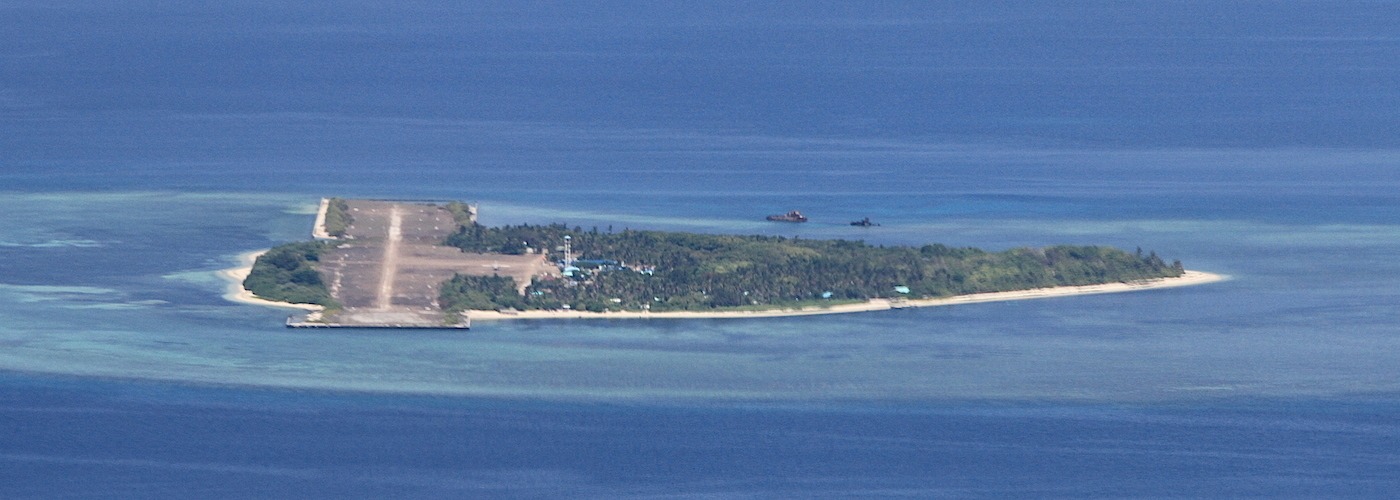
PAG-ASA ISLAND, Philippines – Filipino Randy Dacumos boarded a ship bound for Pag-asa (Thitu) island in 2008 after agreeing to join a team of construction workers hired to build houses in the West Philippine Sea (South China Sea) also claimed by China, Taiwan, and Vietnam.
He did not give it much thought when his foreman first told
him about the assignment. Jobs were scarce. He was single and had no
responsibilities to leave behind. He expected to be back home as soon as they
finished the job.
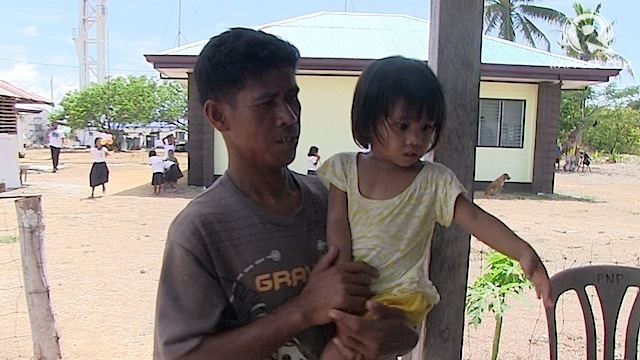
QUIET LIFE: Like many construction workers hired for temporary work in Pag-asa island, Randy Dacumos decided to settle in the isolated island. Rappler photo
“I came from the town of Roxas
in Palawan for a construction work. I ended up
liking it here. I later became an employee of the municipal hall," Dacumos
told Rappler in Filipino.
He has sailed back home a few times, but it's here where he had chosen to build a life and a family. “It’s quiet here. Life is good. We are able to save because everything is free,” he added.
Dacumos and a little over a hundred others constitute a small Filipino community in the island about 300 nautical miles from mainlandPalawan . Everything they need to survive in a place that
cannot grow rice or corn is provided to them by the local government – housing,
solar home system for electricity, and food packages that include 14 kilos of
rice per person a month, cooking oil, canned good, noodles, salt and sugar.
There's cable TV signal for those who can afford the monthly fees, and the municipal government is working to connect the school library to the Internet.
Pag-asa, a Filipino word which means hope, is a barangay (village) and the political seat of power of Palawan’smunicipality of Kalayaan
Like a big family
Kalayaan Mayor Eugenio Bito-onon, who came fromPalawan ’s Brooke’s Point town, arrived on the island on a
C-130 plane in 1997 after taking the job as municipal planning officer. There
were only about 20 residents then, he recalled, because it was previously
reached only by Filipino troops manning military outposts. Aside from the
runway, the municipal hall, multi-purpose hall, and a 5-bed lying in clinic
were already in place when he arrived.
"When I saw the place, I said 'This is so beautiful.' It's an island. It's like a resort. But most of the people here were soldiers," Bito-onon said in Filipino.
He witnessed the civilian population grow. Most of them were visiting construction workers like Dacumos, municipal employees like the mayor, and their relatives.
“It’s not so hard to live in the island. The government is very supportive. We’re just like a big family,” Bito-onon told Rappler in Filipino.
"Basta yung mga matakaw sa alak at basagulero, pinapauwi ko para di makahawa. Nakakaipon na rin ang mga matino at matibay sa isla (I send home those who turn out to be drunkards and troublemakers so they don't influence the residents. The good ones are able to save.)," he added.
He has sailed back home a few times, but it's here where he had chosen to build a life and a family. “It’s quiet here. Life is good. We are able to save because everything is free,” he added.
Dacumos and a little over a hundred others constitute a small Filipino community in the island about 300 nautical miles from mainland
There's cable TV signal for those who can afford the monthly fees, and the municipal government is working to connect the school library to the Internet.
Pag-asa, a Filipino word which means hope, is a barangay (village) and the political seat of power of Palawan’s
Like a big family
Kalayaan Mayor Eugenio Bito-onon, who came from
"When I saw the place, I said 'This is so beautiful.' It's an island. It's like a resort. But most of the people here were soldiers," Bito-onon said in Filipino.
He witnessed the civilian population grow. Most of them were visiting construction workers like Dacumos, municipal employees like the mayor, and their relatives.
“It’s not so hard to live in the island. The government is very supportive. We’re just like a big family,” Bito-onon told Rappler in Filipino.
"Basta yung mga matakaw sa alak at basagulero, pinapauwi ko para di makahawa. Nakakaipon na rin ang mga matino at matibay sa isla (I send home those who turn out to be drunkards and troublemakers so they don't influence the residents. The good ones are able to save.)," he added.
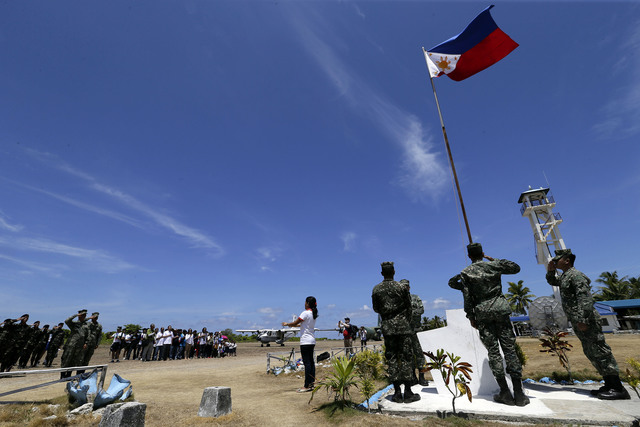
PHILIPPINE FLAG. Filipino residents and soldiers conduct a flag raising ceremony during the visit of Armed Forces of the Philippines military chief General Gregorio Catapang Jr in Pag-asa (Thitu) island on May 11. Photo by Ritchie Tongo/EPA
Over time, Palaweños have heard about the freebies on the island. Many wanted to move here, but Bito-onon said he has to limit the population to 120 to protect the vegetation. "The forest might be denuded if we accommodate more because we rely on firewood to cook. Transportation is difficult. We cannot bring in cooking gas," he said.
There's no harbor on the island, a project that has been repeatedly delayed by lack of funding or by protests fromChina
"We need a harbor. It's okay if they forget our other wishes. Just give us a harbor and we'll take care of the rest," Bito-onon said.
Changing times
For decades, the island residents have been generally oblivious to sporadic incidents elsewhere in theWest
Philippine Sea . They’ve regarded these tensions faraway as matters
to be settled diplomatically.
But they know times have changed. They watchedChina
Over time, Palaweños have heard about the freebies on the island. Many wanted to move here, but Bito-onon said he has to limit the population to 120 to protect the vegetation. "The forest might be denuded if we accommodate more because we rely on firewood to cook. Transportation is difficult. We cannot bring in cooking gas," he said.
There's no harbor on the island, a project that has been repeatedly delayed by lack of funding or by protests from
"We need a harbor. It's okay if they forget our other wishes. Just give us a harbor and we'll take care of the rest," Bito-onon said.
Changing times
For decades, the island residents have been generally oblivious to sporadic incidents elsewhere in the
But they know times have changed. They watched
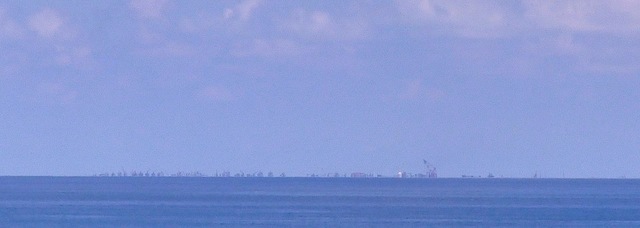
CHINA'S PRESENCE. Filipinos in Pag-asa island can watch the massive reclamation in nearby Subi (Zamora) Reef. Carmela Fonbuena/Rappler
Bito-onon said it’s making the residents uneasy. “Tanaw na tanaw ang high rise crane ng naked eye. May mga beses na hinahabol kami at nagko-cross kami ng warship. Lahat ng ‘yan may impact rin sa ilang pananaw e. Pero sa tagal na rin nila sa isla, hindi na rin sila ganoon kadaling matakot,” said Bito-onon.
(We have a good view of the high-rise crane. There are several instances when warships try to run after us or they cross our bow. All of these are affecting the residents. But they’ve been here for a while. They won’t be scared away so easily.)
It's a distraction that families here would rather not have. Take the case of Randy and Gloria.
Randy weds Gloria
Randy met his wife Gloria here. She’s a widow with two children fromPalawan ’s Taytay municipality.
She arrived in Pag-asa much earlier than Randy upon the prodding of her
brother, whose wife was also a former municipal hall employee.
Gloria also thought she would only come to visit and then take the next ship back home. But fate had other plans.
Bito-onon recalled how Gloria’s sister-in-law successfully matched the two. “Yung ate niya, si Yaga. Siya ang nag-reto-reto kaya nagkatuluyan si Randy at Gloria (It was her Gloria's sister-in-law who played matchmaker for the two. That was how they ended up together.),” he said.
It was Bito-onon himself who wed them in a ceremony in the summer of 2014 after the birth of their daughter.
Bito-onon said it’s making the residents uneasy. “Tanaw na tanaw ang high rise crane ng naked eye. May mga beses na hinahabol kami at nagko-cross kami ng warship. Lahat ng ‘yan may impact rin sa ilang pananaw e. Pero sa tagal na rin nila sa isla, hindi na rin sila ganoon kadaling matakot,” said Bito-onon.
(We have a good view of the high-rise crane. There are several instances when warships try to run after us or they cross our bow. All of these are affecting the residents. But they’ve been here for a while. They won’t be scared away so easily.)
It's a distraction that families here would rather not have. Take the case of Randy and Gloria.
Randy weds Gloria
Randy met his wife Gloria here. She’s a widow with two children from
Gloria also thought she would only come to visit and then take the next ship back home. But fate had other plans.
Bito-onon recalled how Gloria’s sister-in-law successfully matched the two. “Yung ate niya, si Yaga. Siya ang nag-reto-reto kaya nagkatuluyan si Randy at Gloria (It was her Gloria's sister-in-law who played matchmaker for the two. That was how they ended up together.),” he said.
It was Bito-onon himself who wed them in a ceremony in the summer of 2014 after the birth of their daughter.

GIRLFRIENDS. Gloria Dacumos (rightmost) and her friends. Rappler photo
They started a new family as the region saw massive changes.
When Randy arrived in 2008, Gloria Macapagal-Arroyo was president and the country entered into a joint exploration agreement – the Joint Marine Seismic Undertaking (JMSU) – withChina
and Vietnam
She ushered in years of friendship withChina following disputes over its occupation of
Mischief (Panganiban) Reef in 1995 while Filipino troops were away to take
shelter from a bad weather and what the Philippines
But while Arroyo’s JMSU calmed the seas, she was accused of treason because the site of the JMSU is 80% within the country's EEZ.
Her critics linked the JMSU to the controversial and allegedly graft-ridden loans extended byChina
– North Rail and national broadband deal projects, among others – as the
supposed reward for Philippine officials for “selling out” the Philippines
President Benigno Aquino III would succeed her in 2010 and tension withChina
Two years later, in 2012, the situation exploded into a naval standoff in Scarborough Shoal off the coast of Zambales province inLuzon . It resulted in the practical occupation by the
Chinese of the fertile fishing ground that used to provide livelihood to
Filipino fishermen.
This incident, also within in the country's EEZ, would prompt thePhilippines to
file its historic arbitration case against China
China China
'May dalawang klase ng tao sa mga social media. Ang tawag ko doon utak pulbura at saka hindi utak pulbura. Maraming mga utak pulbura hindi nila naiintindihan ang situwasyon doon sa ground.'
They started a new family as the region saw massive changes.
When Randy arrived in 2008, Gloria Macapagal-Arroyo was president and the country entered into a joint exploration agreement – the Joint Marine Seismic Undertaking (JMSU) – with
She ushered in years of friendship with
But while Arroyo’s JMSU calmed the seas, she was accused of treason because the site of the JMSU is 80% within the country's EEZ.
Her critics linked the JMSU to the controversial and allegedly graft-ridden loans extended by
President Benigno Aquino III would succeed her in 2010 and tension with
Two years later, in 2012, the situation exploded into a naval standoff in Scarborough Shoal off the coast of Zambales province in
This incident, also within in the country's EEZ, would prompt the
'May dalawang klase ng tao sa mga social media. Ang tawag ko doon utak pulbura at saka hindi utak pulbura. Maraming mga utak pulbura hindi nila naiintindihan ang situwasyon doon sa ground.'
- Kalayaan Mayor Eugenio Bito-onon
Randy and Gloria are hoping for the best. “Minsan kapag nababalitaan sa TV, kinakabahan kami. Nanalangian kami nasana
Randy takes comfort in knowing that none of them have been hurt in spite of the reports. Unlike the situation in Scarborough Shoal, the fishermen of Pag-asa island are not being harassed.
In this part of theSouth China Sea ,
Mayor Bito-onon said the fishermen coming from different countries peacefully
co-exist although illegal fishing is a constant concern.
And while Chinese media had reported supposed plans to invade Pag-asa, Mayor Bito-onon dismissed it. “Hindi ako naniniwala na kukunin ngChina China para kunin pa ang mga isla natin (I
don’t believe that China
will take the islands of the Philippines
Randy and Gloria are hoping for the best. “Minsan kapag nababalitaan sa TV, kinakabahan kami. Nanalangian kami na
Randy takes comfort in knowing that none of them have been hurt in spite of the reports. Unlike the situation in Scarborough Shoal, the fishermen of Pag-asa island are not being harassed.
In this part of the
And while Chinese media had reported supposed plans to invade Pag-asa, Mayor Bito-onon dismissed it. “Hindi ako naniniwala na kukunin ng
JUST ANOTHER DAY. Soldiers and civilians on Pag-asa Island. Photo by Vincent Go/Rappler
Outgunned PH military
On May 11, AFP chief General Gregorio Catapang Jr visited Pag-asa in the first known visit of a Philippine military chief to the disputed island in almost a decade. (WATCH: VLOG: PH military chief tours disputed South China Sea)
“I’m visiting this place to establish the fact that Pag-asa is a territory of the Republic of thePhilippines ,”
Catapang told reporters during the visit that China
Public reaction to the Philippine military's actions mirrors the split among government officials. There are those who call for a more aggressive response toChina ,
especially in the social media, and there are those who feel military
statements and photo releases relating to China
Bito-onon bats for sobriety. "May dalawang klase ng tao sa mga social media. Ang tawag ko doon utak pulbura at saka hindi utak pulbrura. Maraming mga utak pulbura hindi nila naiintindihan ang situwasyon doon sa ground," he said. "Kailangan tanawin siya sa isang paraan na (We have to view it from the perspective of a) peaceful, harmonious coexistence," he added.
The government has been too careful not to antagonizeChina
A military officer said they are avoiding a situation where the ramming incidents inScarborough would be
repeated in the Spratlys, where the military has several outposts that can only
be reached by ships.
On the ground, the troops are not lacking in resolve but they can only do so much without the hardware. “Bilang isang sundalo, nandito po kami para ipagtanggol at bantayan po angWest
Philippine Sea lalong lalo dito sa Pag-asa,” said
Corporal Tychico Octobre of the Philippine Marines, who has been guarding the
shores of Pag-asa in the last 5 months.
But they find it difficult to repel even illegal fishermen who do not hesitate to come near the island. The Philippine Coast Guard is also present here, but it has a few men and fewer boats. They work under the supervision of the Philippine Navy.
"Ang ginagawa ng coast guard hinahabol nila at wina-warning-an kapag may lumalapit sa area,” said Coast Guard spokesperson Lt Commander Armand Balilo, who joined the May 11 trip to the island. "Nasasaway naman nila. Kaya lang depende kasi may times na baka hindi nila nakita. Sabi ko nga sa kanila, just be very alert lalo na sa report ng tao. Kapag na-report sa kanila, pinupuntahan naman nila," Balilo added.
Outgunned PH military
On May 11, AFP chief General Gregorio Catapang Jr visited Pag-asa in the first known visit of a Philippine military chief to the disputed island in almost a decade. (WATCH: VLOG: PH military chief tours disputed South China Sea)
“I’m visiting this place to establish the fact that Pag-asa is a territory of the Republic of the
Public reaction to the Philippine military's actions mirrors the split among government officials. There are those who call for a more aggressive response to
Bito-onon bats for sobriety. "May dalawang klase ng tao sa mga social media. Ang tawag ko doon utak pulbura at saka hindi utak pulbrura. Maraming mga utak pulbura hindi nila naiintindihan ang situwasyon doon sa ground," he said. "Kailangan tanawin siya sa isang paraan na (We have to view it from the perspective of a) peaceful, harmonious coexistence," he added.
The government has been too careful not to antagonize
A military officer said they are avoiding a situation where the ramming incidents in
On the ground, the troops are not lacking in resolve but they can only do so much without the hardware. “Bilang isang sundalo, nandito po kami para ipagtanggol at bantayan po ang
But they find it difficult to repel even illegal fishermen who do not hesitate to come near the island. The Philippine Coast Guard is also present here, but it has a few men and fewer boats. They work under the supervision of the Philippine Navy.
"Ang ginagawa ng coast guard hinahabol nila at wina-warning-an kapag may lumalapit sa area,” said Coast Guard spokesperson Lt Commander Armand Balilo, who joined the May 11 trip to the island. "Nasasaway naman nila. Kaya lang depende kasi may times na baka hindi nila nakita. Sabi ko nga sa kanila, just be very alert lalo na sa report ng tao. Kapag na-report sa kanila, pinupuntahan naman nila," Balilo added.
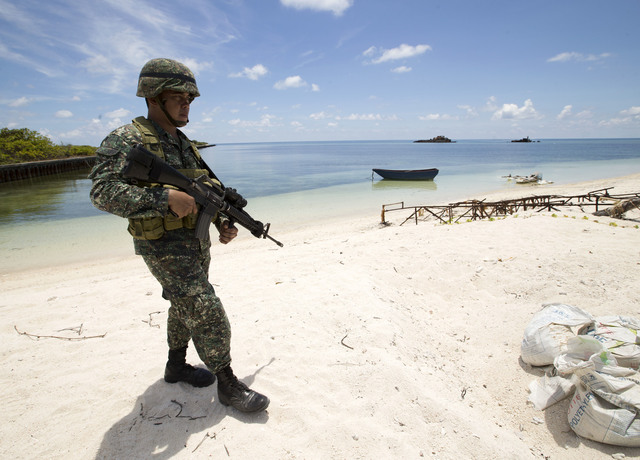
MARINE. Filipino soldier Tychico Octobre patrols on the shores of Pagasa (Thitu) island in the Spratlys. Photo by Ritchie Tongo/EPA
The mayor’s dream
In spite of the worsening situation, Mayor Bito-onon is busy making the island accessible to tourists.
“We have long been promoting Pag-asa or Kalayaan to tourism but we’re only doing a backyard approach. We do not have that much money but we have a roadmap for developing tourism,” Bito-onon said in a joint press conference with Catapang here.
He is building a jump-off station in mainlandPalawan , where tourists will ride a shuttle that will
bring them to a small steel-hulled boat for a 26-hour trip to the island. Here,
there will be a lodging house and a Pasalubong
Center
It’s an opportunity for tourists who are willing to wait even years to get booked for the rare trip. The steel-hulled boat that can accommodate 25 tourists at a time is now being built inSubic ,
costing the municipality about P10 million. Bito-onon said the first trip will
bring in construction supplies.
He now has clients. Last month, a ham radio station was set up on the island, connecting it to a community of 85,000 adventurers in 120 countries. “In their community, Pag-asa or Kalayaan is No. 19 in their “rare-to-go” list. Tourism is feasible for them because they want adventure,” Bito-onon said.
Bito-onon is eagerly awaiting a favorable ruling on the country’s arbitration case, which is expected next year. “I appreciate the arbitration case. It will settle [the disputes] permanently and legally. Doon na rin ako sumunod na kapag natapos ang arbitration case, paspasan na ang Pilipinas na mag-develop,” Bito-onon told Rappler (Once the case is settled, then we can fast-track the development here.)
The mayor’s dream
In spite of the worsening situation, Mayor Bito-onon is busy making the island accessible to tourists.
“We have long been promoting Pag-asa or Kalayaan to tourism but we’re only doing a backyard approach. We do not have that much money but we have a roadmap for developing tourism,” Bito-onon said in a joint press conference with Catapang here.
He is building a jump-off station in mainland
It’s an opportunity for tourists who are willing to wait even years to get booked for the rare trip. The steel-hulled boat that can accommodate 25 tourists at a time is now being built in
He now has clients. Last month, a ham radio station was set up on the island, connecting it to a community of 85,000 adventurers in 120 countries. “In their community, Pag-asa or Kalayaan is No. 19 in their “rare-to-go” list. Tourism is feasible for them because they want adventure,” Bito-onon said.
Bito-onon is eagerly awaiting a favorable ruling on the country’s arbitration case, which is expected next year. “I appreciate the arbitration case. It will settle [the disputes] permanently and legally. Doon na rin ako sumunod na kapag natapos ang arbitration case, paspasan na ang Pilipinas na mag-develop,” Bito-onon told Rappler (Once the case is settled, then we can fast-track the development here.)


No comments:
Post a Comment
Note: Only a member of this blog may post a comment.